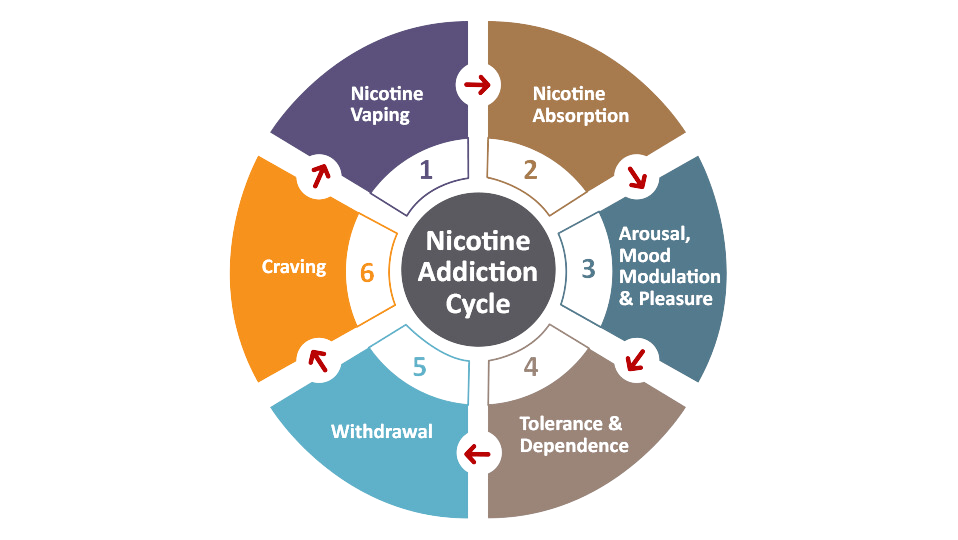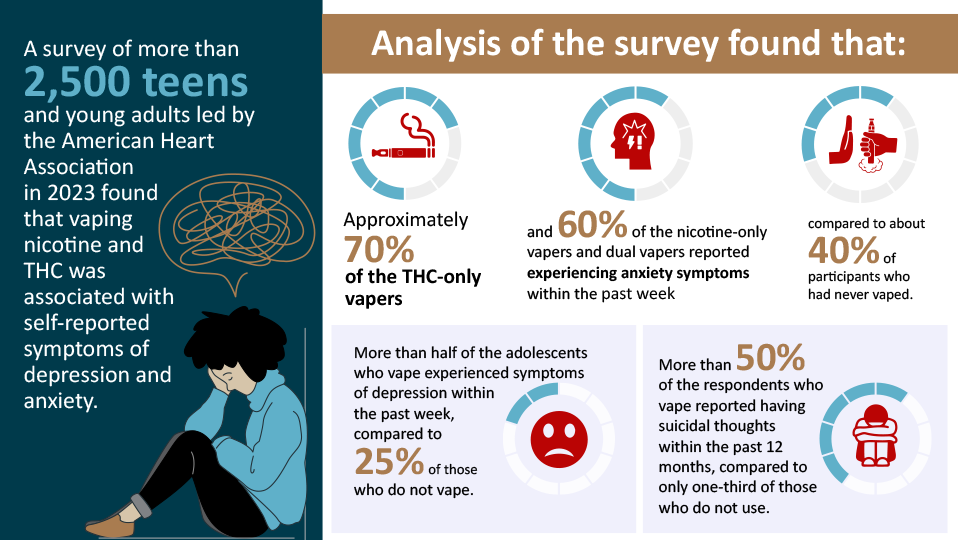The Detrimental Intersection of Vaping & Youth Mental Health
Over the past decade, there has been a notable surge in the number of young people turning to vaping products that contain nicotine, a trend exacerbated by the ongoing youth mental health crisis.
Much of this rise can be attributed to the deceptive marketing tactics employed by the tobacco industry, leading many youths to perceive vaping as a means of stress relief.
According to data from the Truth Initiative, a majority of youth who have used e-cigarettes started vaping to decrease their feelings of stress, anxiety or depression, and 50% of youth report they continue to vape to deal with stress or anxiety.
While youth may turn to vaping to deal with their increasing stress, the evidence shows that vaping can have the opposite effect, actually worsening mental health symptoms, and creating a cycle of addiction that has negative consequences on the physical and mental health of youth.
Many young people are unaware that vaping as a coping strategy may actually make them feel worse. School health staff have a critical role in increasing awareness of the connections between youth vaping and mental well-being.
The Nicotine Addiction Cycle
An understanding of the nicotine addiction cycle can help to contextualize how vaping and other uses of nicotine intersects with mental health.
The cycle starts once a young person uses a vape. This initial experience often includes moments of euphoria and improved mood, which can be intensely pleasurable.
However, this pleasure is short-lived. As it dissipates, youth may repeatedly vape to try and recreate that pleasurable sensation.
This repeated usage can quickly lead to the development of a high tolerance, ultimately resulting in nicotine dependence. This dependence manifests through withdrawal symptoms, which may trigger feelings of anxiety, irritability, and a focus on when they can vape next to recapture that sense of well-being.
This cycle of craving perpetuates itself, creating a continuous loop.
Nicotine Impact on the Brain
Nicotine constricts blood vessels and increases heart rate. Research suggests that nicotine may trigger cortisol production which causes us to falsely believe that nicotine helps us manage stress more effectively.
However, by regularly consuming a substance that replicates a stress response in our bodies when performing everyday tasks, we risk overexposing our bodies to cortisol and other stress hormones that disrupt the body’s processes and put us at risk for poor mental health.
Nicotine also increases nicotinic receptors over time, which provides that stressful feeling every time those receptors aren’t getting nicotine.
ADHD & Nicotine Dependence
- Evidence suggests a complex relationship exists between ADHD and tobacco use, including vaping, which may include an increased risk for nicotine dependence.
- Adolescents with ADHD were more likely to experiment with vaping and cigarettes.
- Tobacco use may be an attempt to self-medicate for symptoms of ADHD such as distractibility, inattention, and hyperactivity.
- Individuals with ADHD may also be more susceptible to the negative effects of nicotine.
Nicotine & Sleep
- Nicotine can increase heart rate, blood pressure, and alertness, making it harder to fall asleep and stay asleep.
- Vaping products also contain a variety of chemicals, including flavorings and additives that may have unknown effects on sleep.
- Some people may wake up during the night to use their vaping devices, which can also interfere with the natural sleep cycle and lead to daytime fatigue and sleepiness.
Mental Health Benefits of Vaping Cessation
Symptoms of anxiety and depression tend to decrease after quitting/reducing vaping (or cigarettes). The cessation of nicotine dependence allows people to feel calmer and more relaxed.
Quitting use may also give youth a sense of satisfaction or achievement in addition to freeing them from the fear of stigma associated with smoking or vaping.
How School-Based Health Centers & Wellness Centers Can Support Youth with Addiction
It’s important to remember that supporting youth with addiction is a complex and multifaceted issue that requires a collaborative approach involving schools, school health partners, parents/guardians, and community resources.
- Prevention Education: SBHC/WCs can implement prevention education programs that provide age-appropriate information about the risks and consequences of addiction, including substance use, gambling, gaming and other addictive behaviors.
- Early Intervention: SBHC/WCs can have mechanisms in place to identify the early signs of addiction in students, such as school-wide screenings.
- Counseling and Support: SBHC/WCs can offer counseling services to students struggling with addiction, including individual and group counseling, Brief Intervention and Motivational Interviewing models, and support groups.
- Community Resources: SBHC/WCs can connect students and their families to community resources such as addiction treatment programs, counseling services, support groups and other such support services.
- Youth Engagement: SBHC/WCs can engage young people in peer-to-peer education related to the harms of vaping and its impacts on mental health.
- Alternatives to Punitive Measures: SBHC/WCs can advocate for alternatives to punishment that support cessation efforts.
- Collaboration with Parents/Guardians: SBHC/WCs should involve parents/guardians in supporting students with addiction.
Therapeutic Interventions
- Harm Reduction
- Motivational Interviewing
- Brief Intervention
- Refusal Strategies
- Nicotine Refusal Therapy
- Cognitive Behavioral Therapy





